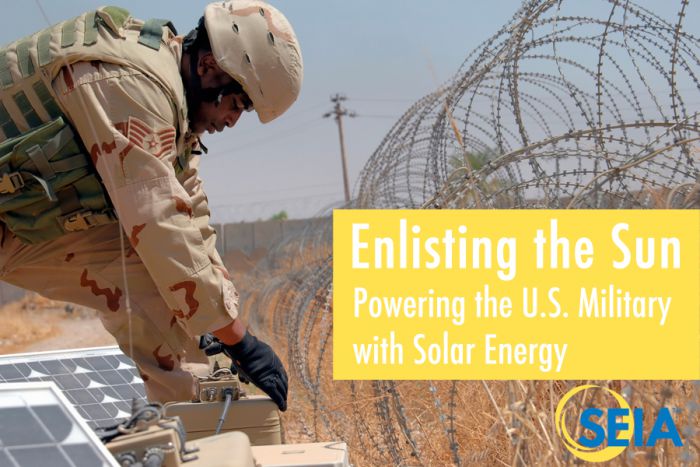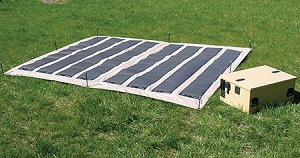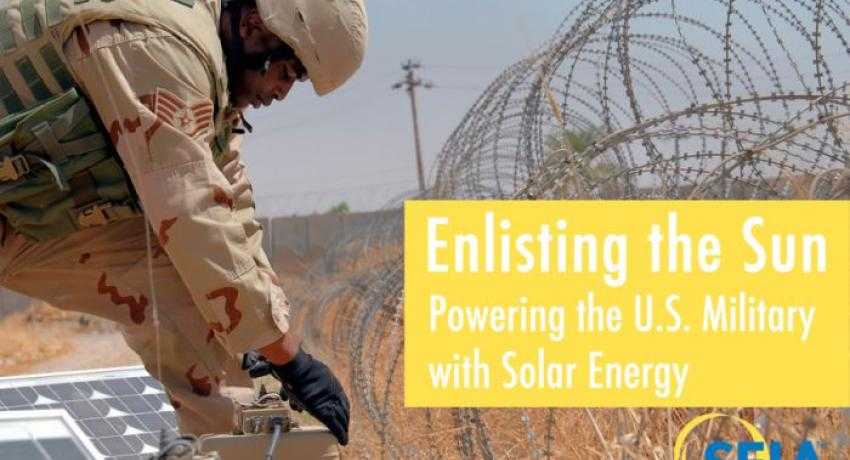Seeing security in solar from bases to battlefields US military now has 130 MWs of PV, more on the way
 The U.S. military has been adding in solar and renewable energy rather quickly of late. A new Solar Energy Industries Association (SEIA) report, Enlisting the Sun: Powering the U.S. Military with Solar Energy, looks into the ways that solar power is making for a more secure military from the battlefield to the home front.
The U.S. military has been adding in solar and renewable energy rather quickly of late. A new Solar Energy Industries Association (SEIA) report, Enlisting the Sun: Powering the U.S. Military with Solar Energy, looks into the ways that solar power is making for a more secure military from the battlefield to the home front.
The world’s largest energy user, the U.S. Department of Defense said last year that it would install 3 gigawatts of solar by 2025, with each branch of the military installing 1 gigawatt. It’s already making good on the promise. “As of early 2013, there are more than 130 megawatts (MWs) of solar photovoltaic energy systems powering Navy, Army and Air Force bases in at least 31 states and the District of Columbia,” according to the new report. “The Navy has installed more solar than either the Army or Air Force, with more than 58 MW at or near bases in 12 states and DC. The Air Force follows the Navy with 38 MW of installed solar capacity, while the Army has deployed more than 36 MW.”
“Today, the Defense Department is one of the largest institutional users of solar energy in the world,” said Rhone Resch, SEIA president and CEO. “After using solar energy on military bases and in the field, many returning servicemen and servicewomen are finding great career opportunities at solar firms, which have been actively recruiting veterans. Many other veterans have started firms of their own.”
It’s not just that the military or service members are trying to green their image. “These aggressive renewable energy targets are a response to rising energy costs, potential energy supply disruptions and the need for more secure and clean energy generation and distribution,” the report stated. “In the past year alone, the DOD spent more than $20 billion on energy and consumed over five billion gallons of oil.” Solar offers fixed energy costs—at currently competitive costs—under power-purchase agreements, allowing the military to reduce its energy costs and have a better idea of what they will be in the future.
 What’s more is that solar doesn’t just have to be used in static applications like on bases in the U.S. “In Afghanistan…U.S. troops in battle zones are using everything from portable solar panels to solar tent shields to cutting-edge, solar-powered security systems to help them successfully carry out critical missions,” the report said. Solar is quick to deploy, operates silently and requires no fuel, which means forward operating units don’t need diesel generators or the fuel to operate them. Getting fuel to such installations has been incredibly costly, in terms of lives lost as well as in transportation costs. The report observed that DOD gets gas for $1 a gallon, but transporting it up to the front line in Afghanistan can cost $400 a gallon.
What’s more is that solar doesn’t just have to be used in static applications like on bases in the U.S. “In Afghanistan…U.S. troops in battle zones are using everything from portable solar panels to solar tent shields to cutting-edge, solar-powered security systems to help them successfully carry out critical missions,” the report said. Solar is quick to deploy, operates silently and requires no fuel, which means forward operating units don’t need diesel generators or the fuel to operate them. Getting fuel to such installations has been incredibly costly, in terms of lives lost as well as in transportation costs. The report observed that DOD gets gas for $1 a gallon, but transporting it up to the front line in Afghanistan can cost $400 a gallon.
“America’s solar companies, which employ nearly 120,000 workers from coast to coast, are very proud of the contributions they’re making to help the men and women of the U.S. military to defend our nation,” Resch said. “Solar clearly is making a big difference—both on the front lines and in military installations from North Carolina to Hawaii. Many of the technologies being used by the military today have been adapted for use from consumer products.”




